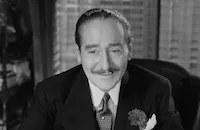Synopsis: In Belgium, young Jeanne is left with her nanny Marie (Helen Raymond) when her mother Hortense (Gertrude Astor) remarries; her stepfather Elton Reeves (Wilfred Lucas) doesn't want small children around. When Hortense returns for Jeanne five years later, Marie lies and says she has drowned, because she doesn't want to give Jeanne up. More time passes. Jeanne (now Mary Pickford) leaves with other refugees when the Germans invade. Taking two orphans she picks up on the road, the girl goes to New York. Jeanne cannot get the attention of her Mother, a distracted socialite - so she instead becomes a maid in her house, 'sneaking in through the back door.'
Through the Back Door is cleverly contrived to bring out all the possibilities in Mary Pickford's screen personality. She starts as a fun-loving farm girl playing tricks like pretending she's caught a huge fish from a puddle in the road. Caught tracking mud into the house, she cleans the floor by riding two scrubbing brushes like they were ice skates, turning the floor into a soapy rink.
By 1921 Pickford was reaping the benefits of a firmly established star persona. She maintained the illusion of a golden-curled child angel just by dressing in a pinafore and surrounding herself with tall people. Jeanne is introduced sitting next to an unusually large dog, a trick that makes her look like a tot - at age 29. The rest of her performance is a combination of wistful looks for close-ups and cutesy mugging, especially a popular pursed-lip "ooh!" expression. Plenty of wide-eyed staring guarantees an interpretation of unspoiled innocence.
The scenario adroitly hits every stop on the Pickford checklist. For emotionalism we have Mother Love and the adoption of war orphans. Every scene makes room for knockabout comedy, as when the Belgian orphans run about like the Katzenjammer kids. The 'innocent' farm life of the first reels is contrasted with the hoity-toity upper crust on Long Island. Jeanne must play the maid in her own mother's house, not daring to come forward and declare her true identity. She then saves the day (and Mom's marriage) by uncovering a dastardly plot by a husband-wife confidence team to alienate her stepfather's attentions. Following typical convention, the females are 100% responsible for male behavior - when dad strays, it's the other woman's fault.
While locked in a closet, Jeanne gets the goods on the crooked houseguests, one of whom is played by a very young Adolphe Menjou. Jeanne naturally prevails and takes her rightful place as a pampered rich girl in fancy clothes, now being pursued by a handsome young man. He's from a good family but won our approval by being attracted to her when she was still a maid.
Through the Back Door is shot in a straightforward manner on handsome sets, with direction shared by Pickford's brother Jack and Alfred Green, a pioneer who would be an industry fixture for almost five decades. Southern California shows its versatility by providing appropriate backgrounds for a Belgian farm, a refugee-clogged road and a New York mansion.
We are also treated to some good examples of the silent movie art of inter-titles, which carry dialogue but also set scenes and identify major plot points. The title cards on this offering are particularly witty. All that is needed to establish the location of the Hotel Knickerbocker is a single card reading:
Milestone and Image's DVD of Through the Back Door is a good transfer of a reasonable film print which exhibits moderate flickering and constant fine dirt and scratches. Individual scenes are handsomely tinted. Perhaps the best feature is Robert Israel's sensitive and classy orchestral score. The film is a presentation of The Mary Pickford Foundation.
An added extra is Pickford's 1914 version of Cinderella, a primitive but charming feature that runs 52 minutes. America's Sweetheart is a good fit for the glass slipper story, which holds the interest despite the 'one scene - one camera angle' direction. Another menu choice offers some stills from the main feature. The cover art is a reproduction of what now is probably a priceless stone litho one-sheet.
Image's menu interface shares a welcome feature with Warner Home Video: Hit the menu button during the opening logos and the disc jumps right to the 'start picture' screen, skipping everything in between.
For more information about Through the Back Door, visit Milestone Films. To order Through the Back Door, go to TCM Shopping.
by Glenn Erickson



















